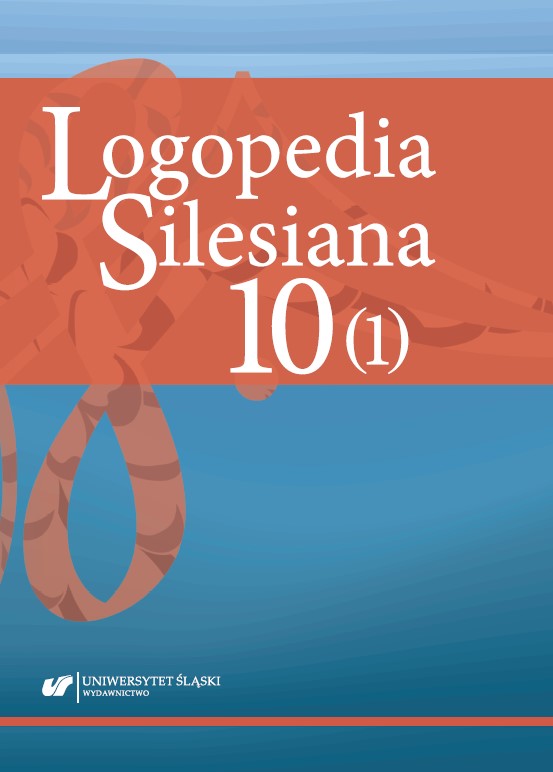Adamek, D., Tomik, B. (2005). Stwardnienie boczne zanikowe. Kraków: ZOZ Ośrodek UMEA Shinoda – Kuracejo.
Google Scholar
Bach, J.R., Vega, J., Majors, J., Friedman, A. (2003). Spinal muscular atrophy type 1 quality of life. American Journal of Physical Medicine & Rehabilitation, 82(2), 137–142.
Google Scholar
Cardenas, J., Menier, M., Heitzer, M.D., Sproule, D.M. (2019). High healthcare resource use in hospitalized patients with a diagnosis of spinal muscular atrophy type 1 (SMA1): Retrospective analysis of the kids’ inpatient database (KID). PharmacoEconomics – Open, 3, 205–213.
Google Scholar
Chiriboga, C.A. (2017). Nusinersen for the treatment of spinal muscular atrophy. Expert Review of Neurotherapeutics, 17(10), 955–962.
Google Scholar
Cieszyńska, J. (2012). Metody wywoływania głosek. Kraków: Wydawnictwo Metody Krakowskiej.
Google Scholar
Cieszyńska, J., Korendo, M. (2008). Karty diagnozy 10 etapów rozwoju dziecka od 4. do 36. miesiąca życia. Kraków: Wydawnictwo Edukacyjne.
Google Scholar
Groen, E.J.N., Talbot, K., Gillingwater, T.H. (2018). Advances in therapy for spinal muscular atrophy: promises and challenges. Nature Reviews Neurology, 4, 214–224.
Google Scholar
Grycman, M. (2015). Sprawdź, jak się porozumiewam. Ocena efektywności porozumiewania się dzieci ze złożonymi zaburzeniami komunikacji wraz z propozycjami strategii terapeutycznych. Kwidzyn: Stowarzyszenie Rehabilitacyjne Centrum Rozwoju Porozumiewania.
Google Scholar
Hausmanowa-Pietruszewicz, I. (2015). Zanik rdzeniowy mięśni (dziecięcy i młodzieńczy). W: J. Czochańska (red.), Neurologia Dziecięca (s. 502–508). Warszawa: Wydawnictwo Lekarskie PZWL.
Google Scholar
Jak skuteczny jest lek Spinraza? (s.a.). Fundacja SMA, https//www.fsma.pl/leki/spinraza/skutecznosc/ [data dostępu: 8.02.2021].
Google Scholar
Jędrzejewska, M., Kostera-Pruszczyk, A. (2016). Rdzeniowy zanik mięśni – nowe terapie, nowe wyzwania. Neurologia dziecięca, 25(51), 11–17.
Google Scholar
Jorde, L.B., Carey, J.C., Bamshad, M.J. (2014). Genetyka medyczna. Wrocław: Elsevier Urban & Partner.
Google Scholar
Khadilkar, S.V., Yadav, R.S., Patel, B.A. (2018). Neuromuscular disorders. Singapore: Springer.
Google Scholar
Kostera-Pruszczyk, A. (2017). Choroby nerwowo-mięśniowe. W: B. Steinborn (red.), Neurologia wieku rozwojowego (s. 1000–1032). Warszawa: Wydawnictwo Lekarskie PZWL.
Google Scholar
Kostera-Pruszczyk, A. (2020). Materiały pokonferencyjne, V Warszawskie Dni Chorób Nerwowo-Mięśniowych, 27–28.11.2020.
Google Scholar
Lorens, G., Karwowska, A., Więcek-Poborczyk, I. (2017). Gesty obrazujące ruchy artykulatorów. Gdańsk: Harmonia.
Google Scholar
Machoś, M. (2018). Diagnoza bazowych umiejętności komunikacyjnych. Karty obserwacji. Bytom: Ergo-Sum.
Google Scholar
Masgutova, S., et al. (2018). MNRI Terapia NeuroTaktylna dr Svetlany Masgutowej. Warszawa: Międzynarodowy Instytut dr Svetlany Masgutovej.
Google Scholar
Mastella, Ch., Ottonello, G. (eds.). (2016). Z SMA1 na co dzień. Vademecum opieki nad dzieckiem z najcięższą postacią rdzeniowego zaniku mięśni. [Tłum. M. Jędrzejczyk]. Warszawa: Fundacja SMA.
Google Scholar
McGuire, J. (2011). Neuromuscular disorders. W: P. Aronson, H. Werner (red.), Netter’s pediatric (s. 508–517). Philadelphia: Elsevier Inc.
Google Scholar
Mercuri, E., Bertini, E., Iannaccone, S.T. (2012). Childhood spinal muscular atrophy: controversies and challenges. Lancet Neurology, 11, 443–452.
Google Scholar
Mercuri, E., et al.(2018). Diagnosis and management of spinal muscular atrophy: Part 1: Recommendations for diagnosis, rehabilitation, orthopedic and nutritional care. Neuromuscular Disorders, 28, 103–115.
Google Scholar
Obrycki, Ł. (2020). Postępowanie diagnostyczno-terapeutyczne u pacjentów z rdzeniowym zanikiem mięśni. Standardy Medyczne, 17, 257–261.
Google Scholar
Pluta-Wojciechowska, D. (2020). Terapia strategiczna dyslalii obwodowej. Inspiracje do ćwiczeń warg i języka dla dzieci i dorosłych. Bytom: Ergo-Sum.
Google Scholar
Prior, T.W. (2007). Spinal muscular atrophy diagnostics. Journal of Child Neurology, 22 (8), 952–956.
Google Scholar
Raczek, D. (2020). Program wczesnego dostępu do leku risdiplam. Fundacja SMA, https://www.fsma.pl/2020/11/program-wczesnego-dostepu-do-leku-risdiplam/ [data dostępu: 10.02.2021].
Google Scholar
Regner, A. (2019). Wspomagane techniki manualne wspomagające terapię ustno-twarzową. Wrocław: Continuo.
Google Scholar
Risdiplam (s.a.). Fundacja SMA, https://www.fsma.pl/leki/evrysdi/ [data dostępu: 20.02.2020].
Google Scholar
Saniewska, E., Saniewska, N.E. (2019). Wiedza pacjentów obciążonych rdzeniowym zanikiem mięśni (SMA) oraz ich opiekunów na temat choroby. Białystok: Prymat.
Google Scholar
Smoczyńska, M., et al. (2015). Inwentarze rozwoju mowy i komunikacji (IRMiK) – Słowa i gesty, Słowa i zadania. Podręcznik. Warszawa: Instytut Badań Edukacyjnych.
Google Scholar
Sumner, Ch., Paushkin, S., Ko, Ch.-P. (2018). Spinal muscular atrophy. Disease mechanisms and therapy. London: Elsevier Inc.
Google Scholar
Szczerba, A., Śliwa, A., Żarowski, M., Jankowska, A. (2018). Molekularne podłoże i terapia rdzeniowego zaniku mięśni. Child Neurology, 27(55), 39–46.
Google Scholar
Winnicka, E. (2020). Trudności w jedzeniu i połykaniu u pacjentów z SMA – propozycja monitorowania i diagnostyki. Standardy Medyczne, 17, 441–453.
Google Scholar


 https://doi.org/10.31261/LOGOPEDIASILESIANA.2021.10.01.05
https://doi.org/10.31261/LOGOPEDIASILESIANA.2021.10.01.05

 10.31261/LOGOPEDIASILESIANA
10.31261/LOGOPEDIASILESIANA